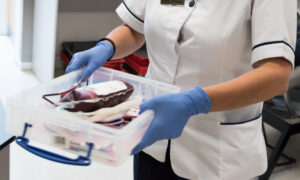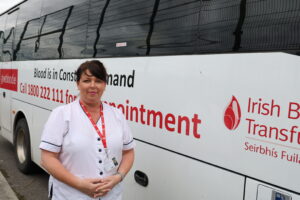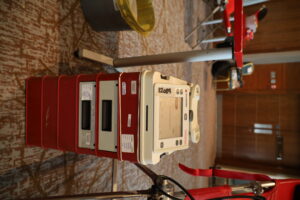The little red dot stuck onto the O rhesus negative bag to mark that it could be used in transfusions to babies is a symbol to warm the hardest heart. Over the past year, I’ve started to donate blood at mobile clinics in Kells, Kingscourt and Ardee, one of 11,000 new donors according to the Irish Blood Transfusion Service’s annual report.
IBTS clinics operate Monday to Thursday from 3.50 until the last appointment at 8pm. ‘If there’s a bank holiday in the month, we have to catch up that day,’ says Iosif Korpas, Area Manager for the North-East region. ‘We will organise a Sunday clinic. The blood supply has to come. We can’t afford to lose days. The demand is higher and higher and we just have to keep going.’
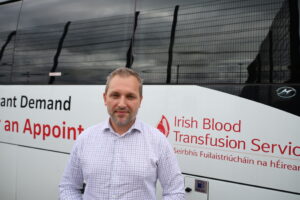
One of the few positives to come from the pandemic is that since March 2020, the appointment system instituted has streamlined the whole process. Potential donors can go onto the Irish Blood Transfusion Service website (giveblood.ie) for the schedule of upcoming clinics nearest to them, and either book a time slot online or ring the number.
Hours before any donor sets foot in the clinic, the staff have been working like a circus fit-up travelling from Ardee to arrive at the venue by roughly 2pm, depending on location, to set up the beds, the tables of supplies, the chairs, the curtained interview areas and the weigher-mixers that take the blood.
Tall, caged trolleys of gear wait to be wheeled in and unloaded bearing a freight of cases and aluminium boxes of machines, heat-sealers and laptops. There are cardboard boxes of wipes, single-use needles, gloves, aprons, paper forms, water cartons, snacks, bottles of cleaning and alcohol solutions, medical device trays, yellow sharps bins, tea-urns and LED tripod work-lamps to light up the murkiest of hotel conference rooms.
Róisín Clarke is a donor attendant who has been working with the Irish Blood Transfusion Service for 23 years. ‘We come to the local community centre, hotel or school. We set up everything and then we have a half-an-hour tea break. And then we start into our specific roles.’
While it’s now mostly appointment-based, she’d still encourage walk-ins. ‘Some people will come when they see your bus or your truck parked outside and they’re very, very welcome. Always very, very welcome.’ She laughs. ‘So we’ll fit them in somewhere.’
At the Aura Leisure Centre in Trim, there’s a jolly hubbub of voices, a mixture of work-talk and gossipy catch-up chat, tinny pop music from the staff’s playlist speakers, beeping machines and of course mobile phone ringtones bouncing off the breeze-block walls. For an aural reference, close your eyes and hear swimming pool sounds, only, you know, with blood.
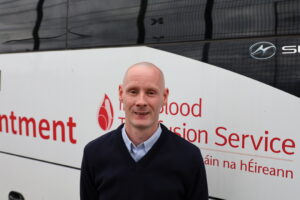
Raymond Laurence is a driver-clerk on the North-East unit. His is one of the friendly faces donors meet at the NE clinics when you head for the registration desk. ‘We would be the meeter-greeters, the front line. We’re the very first ones everybody sees. That’s an important role. That kind of sets the tone of how it goes from there.’
Most of the year, Raymond drives the staff bus. ‘We would go as far over into Cavan as Ballyconnell and Lough Gowna, so we go down as far as Kilcock and Mullingar and places like that. In the wintertime, you’re fighting with the weather.’
Essentially, Raymond confirms the donor number corresponds to the person sitting in front of him and to prevent what’s called ‘a donor mix-up. If that was to happen. That’s serious. That’s very bad. That’s our main job.’
He gives the donor their box-tick questionnaire and information booklet so they can sit and fill that out. These are yes/no questions on your current health, recent medical/dental care, piercings/tattoos, medications, travel and risk factors.
Raymond then ‘would send them on to the next station which is HBs where they get their iron testing.’ Hb is a protein that contains iron and is found in red blood cells and carries oxygen around the body. The donor is called into a curtained cubicle where the attendant or nurse zips through the questionnaire and asks some further questions. If Róisín is put on HBs, ‘you’re doing a donor interview. You’re checking their haemoglobin. That has to be within range. The ladies have to be 12.5 and over and the gentlemen have to be 13.5 and over.’
With a tiny finger-prick, the capillary droplet is guided into a plastic cuvette and slid into the HemoCue machine. My Hb reading was 14.4. Is that alright? ‘The ladies tend to be around the 13/13.5 and the gentlemen can be anywhere from 14-15-16.’
The higher the better it seems? ‘Oh yeah, but there’s a higher range as well. You don’t want to be over that range either. Some of our donors would have haemochromatosis. Previously we didn’t use their blood. Now we do.’
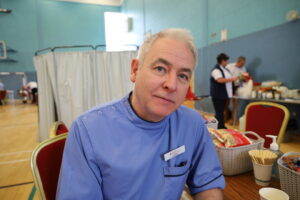 Yorkshireman Andy Kelly has been nursing for thirty-six years, and two years with the IBTS. ‘After registration, they’re going to either a regular donor interview or an extended donor interview. If they pass that, we’ll get them on the beds and bleed them.’
Yorkshireman Andy Kelly has been nursing for thirty-six years, and two years with the IBTS. ‘After registration, they’re going to either a regular donor interview or an extended donor interview. If they pass that, we’ll get them on the beds and bleed them.’
As he’s not sporting any sharpened incisors, I ask Andy for his donor numbers.
‘Do you mean how many I bleed?’ Steady on Andy, but yes.
‘It varies vastly, so if it’s a smaller clinic like Belturbet you’ve only space for maybe six beds so only fifty people may come through all night. A big clinic like this (Trim), you may expect one hundred and thirty in, of course not everyone may be able to donate so you might get a hundred and ten people who’d come through to donate.’
Solid digits. ‘Of those I might personally put a needle in maybe fifteen through the course of that time.’
What about the time length for deferrals when people aren’t allowed to donate just yet?
‘If for example you’ve had a scope, (e.g. endoscopy) you can’t donate for four months, so we defer them. If you’re unwell today, you’re just deferred from this clinic today but you would be able to come back tomorrow.’
Dental deferrals? ‘If you have an ongoing abscess, ongoing dental work or root canal, you can’t really donate until that’s finished. About 24 hours for a filling.’
If you’ve had a tattoo or a piercing, you can’t donate for four months.
How about the fainters? ‘Touch wood, not today. It just depends, it just varies.’
The trestle table’s plywood clearly didn’t suffice as not long after a colleague of his calls out ‘Cold Swab please!’ Andy’s chair legs squeak-scrape on the sports floor as he stands. ‘So this chap’s going down you see…’
Natasha Bedingfield sings these words are my own while a vacant, sweating pale man is tended to by Andy and his colleagues. He’s out for ten seconds, revives and answers ‘Yeah, yeah, yeah, yeah,’ that’s he’s OK.
‘You’ve had a little bit of a faint.’ Then he passes out again. ‘Hello, hello, are with us? How much water? Too much?’
‘Too much’. After eighteen seconds of unanswered hellos, he comes around. ‘Ah you’re back now, you’re back. Good man. How are you feeling?’ asks Andy. The man is speaking and moving again. ‘Well done.’ He’s reassured by a scrum of staff and shuffled over to a reclining bed to recover.
Andy puts up a standing curtain around him for privacy and we shunt the tea-table and chairs a few feet away to give him some room. ‘As you see, you just can’t tell. Claire, here, spotted it straight away and called Cold Swab, tried to bring him around, put him on a rester bed, tilt him obviously, improves circulation and supply.’
‘I’ll have to speak to him to decide if he’s OK to donate again. Of course, you get people in who may possibly suffer from low blood pressure but may not divulge that to you. I need to look at the computer because if it’s a regular thing he may be better off not donating. That information goes back to the NBC (National Blood Centre) in Dublin.’
When I ask staff about the 2022 IBTS report figure that only 3% of the eligible Irish population regularly donate, Róisín says ‘it does surprise me. Very much so.’
‘Those 3% actually that are donating are keeping hospitals in Ireland running, keeping people alive, making surgeries possible, making treatments possible. It’s just unbelievable,’ says Iosif, taking the positive outlook but it’s unbelievable either way.
The same report estimates that 25% of the population will require a blood transfusion at some stage of our lives.
Donors
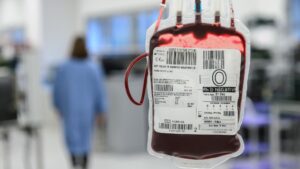 After each donor is unhooked and their donation secured, an attendant guides them to the canteen table for recuperative tea and snacks. Here at the Aura in Trim, some donors are rustling chocolate wrappers, biscuits in hand, the less caffeinated slurping down some hydrating soft drinks. How did people get started donating?
After each donor is unhooked and their donation secured, an attendant guides them to the canteen table for recuperative tea and snacks. Here at the Aura in Trim, some donors are rustling chocolate wrappers, biscuits in hand, the less caffeinated slurping down some hydrating soft drinks. How did people get started donating?
Ciara (48) says ‘My parents did it. And just kind of said come down and we did it in the local clinic, yeah. To introduce it. The family did.’
It’s similar for Caroline who says ‘My mother marched us all in here once we turned 18 and we’re still coming. My Dad never did. Mam did and she said ‘get in there and give blood’ and whoever we were with at the time, our boyfriends came too, that was it, get in and give blood. And I’ve given 56 pints now. Today’s 56, so it is. I’m trying to get my kids to go but they don’t want to – they’re all like I’m afraid of needles.’
Parish priest David found ‘the mood took me. It’s good to give something back. A day will come when I will need it or somebody belonging to me so I thought I’d try and pay it forward for that day.’ While he might not feel comfortable preaching from the pulpit about it, David ‘would say it to people. I’ve said it to a few people that I’ve met in the parish today, this is where I’m going, this is what I’m doing today. That it might plant a seed in their mind.’
Everyone seems to like the follow-up texts telling them where their blood was sent. Laura (46) says ‘Yes I do – I love that. My bloods, a few years ago, were going neo-natal which I loved hearing that.’ Ciara agrees ‘I think mine is going there today. It’s a nice feeling. Lovely to hear.’
Just off the blond-wood dancefloor of the Hotel Kilmore Country Club, Neil (53), is helping the Cavan clinic with the Civil Defence. He has 93 donations under his belt. ‘Yeah, so it’s not too bad,’ he says, ‘you should always bring someone with you and it’s your civic duty because you never know the day or the hour you need it yourself.’
The bar shutters are rolled down so the best Neil can provide a donating acquaintance is a 7-up. ‘We ran out of umbrellas, ice and lemon, so…’
If they weren’t brought up to do it, then sometimes a donor’s family provides the spur nevertheless. Breda says ‘When I had children I stopped doing it for a number of years. Then my father got sick and had leukaemia and needed blood. So he was going up to Dublin and getting transfusions every week nearly so I said I’m going to start going back again.’
Neil cracks ‘My young lad should be here, if not he’ll get a clout. His peers, of a similar age, he’s in his twenties, they wouldn’t be arsed. Why should I do that? Why? Why? Why should we bother?’
Catherine (20s) says ‘an awful lot of people don’t do it. I think in my family out of all the cousins, myself, there’s three of us. And one of them’s a nurse. There’s like forty of us.’ She doesn’t think there’s enough of a giveblood.ie presence on the platforms. ‘I see it on the telly, it’s on the ads about donating, how important it is. You have to look for it on social media.’
In Trim, an old man having his tea starts dribbling blood onto the floor. A nurse swoops in to raise his arm, affixes a new plaster and then cleans up the red stuff. Nurse Andy tells me ‘There’s a spills kit under the desk there. We’ve various alcoholic solutions and gloves and masks and aprons and bits and pieces we can use to mop up any spills, but it’s extremely rare something like that…we usually have very few spills.’
‘We try to make it as pleasant as we can,’ says Andy. ‘Unfortunately, the days of Guinness are gone but there you go. What can you do?’ Diageo discontinued the provision of a free stout to replace lost iron in 2010, as it no longer marketed Guinness for any health benefits and couldn’t be sending donors careering into ditches on the way home. Drat and double drat.
Now let’s talk about the heavyhitters, the men and women with the golden arms. James (68) in Cavan is up to one hundred and fifteen. He started in 1975 when he was eighteen back when they only collected it twice a year.
‘If you had those hundred-and-fifteen donations in the one place, you’d have the fill of a couple of creamery cans of blood, like. They all held ten gallons let’s say, so you’d have a couple of those in a hundred-and-fifteen.’
Donors get invited to an annual dinner as a thank-you after the impressive markers of 50 and 100 donations are reached. Caroline in Trim hit the big Five Oh during Covid, she’s now on 56. ‘You get to go for a meal in Kells and then meet the President and the whole lot. Lo and behold, if I didn’t get invited this year the day of the Rod Stewart concert, right? So I rang them up straight away I said, no I don’t want to miss this, I said, so they’ve put me off until next year.’
Of the donors I meet, Charles (75) is the most decorated veteran having given a pint of his blood one hundred and thirty-eight times. He first donated when he was ‘eighteen. In the Protestant Hall in Cavan town.’
It wasn’t his family who encouraged him but the carpenter in a joinery business who Charles was apprenticed to. ‘It was a man that I was serving my time with. He advised me to go. He was only after starting it himself. He was only in his forties I’d say. He was only just after commencing giving blood. He advised me to go.’
NE Area Manager Iosif says ‘People like Charles, for people like him, how many others had the chance to sit at the Christmas table with their families, one more time at least.’
Each whole blood donation provides components that will help on average three patients.
My own whole blood donation at the Gateway Hotel Dundalk takes an hour and seven minutes from when I walk in the door. This is just my fifth time donating. When called, I opt for the right arm. I get settled on the reclining chair, re-confirming my name and DOB while a cuff is put onto my upper arm to exert a small amount of pressure.
The donor attendant scan-beeps all the barcodes of checks and double-checks matching her number to mine to the form to the bag to the weigher-mixer machine.
She wipes the crook of the arm to get rid of any bacteria. I squeeze the plastic bone-shaped hand-gripper twice to increase blood flow and then the sensation of the needle going into the basilic vein is just a very slight pinch. Firstly, a tube of blood is filled and cinched off with the heat-sealer to make sure that if any skin particle has gone into the line accidentally, the separate blood collection bag won’t be contaminated. The tube sample is also then used to test for HIV, Hepatitis B, Hepatitis C, Hepatitis E, HTLV (a blood virus) and syphilis.
The plate on top of the weigher-mixer keeps the blood moving so that the platelets don’t start to clump as it fills into a bag containing anticoagulant fluid. Rate of blood-flow varies from person to person depending on the vein they take it from, their health, age and hydration level – fifteen minutes is the time-limit to keep the blood viable. To a reassuringly maternal ‘80s vibe of Eurythmics and Whitney Houston, it takes ten minutes and one second for the machine to extract 470mls of my blood and then with a beep it automatically stops the flow. That’s me done for another 90 days. The following week’s text thanking me for donating tells me my blood was issued to Temple Street.
When the clinic is finished, a temperature-controlled van collects the blood donated and brings it all back to the National Blood Centre at St. James’s Hospital for testing and separation into its components to create all the products and therapeutic doses.
All of Ireland’s blood is then shipped from Dublin to the hospitals for use in adult, infant and intrauterine transfusions. Surgeries, pregnancies, everything.
As Ciara, a donor in Trim, says it’s ‘only for such a short time – you get the prick in and that’s it.’ Now reader, stop it, it’s not my fault you have a dirty mind.
Who’s afraid of a little prick? 97% of those of us eligible to donate, that’s who.
The lifeblood of the organisation that the IBTS and the HSE run on is not, for once, a corporate metaphor.
When a quarter of us will need a transfusion at some stage in our lives, you can work out who the pricks are. And if it’s you, you know what to do.
Giveblood.ie
